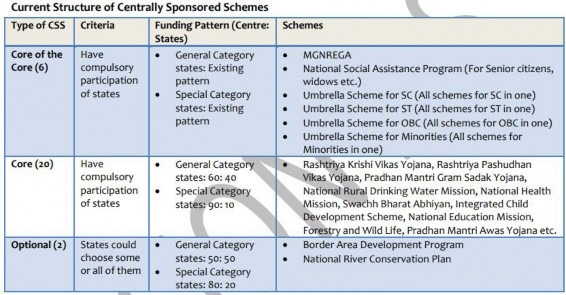2.5.2. Centrally Sponsored Schemes (CSS)
In the areas requiring national effort, it is imperative for the Centre to make interventions. Government of India tries to do this through various programmes and polices including the CSS. Central Government has introduced several schemes in areas that are national priority like health, education, agriculture, skill development, employment, urban development, rural infrastructure etc. Several of these sectors fall in the sphere of activity of States.

In fact, CSS is the biggest component of Central Assistance to state plans (CA), where states don’t have much flexibility. In the initial years of planning in India, the number of CSS was very large (190 at the end of Fifth Plan which increased to 360 at the end of Ninth Plan). Thus, the CSS have remained a major bone of contention between the Union and State Governments owing to following reasons:
♤ Inability to provide matching funds: To access the funds from center under some CSS, there has to be a definite percentage contribution from the States. The pattern of assistance to States varies. Generally it is Central Government’s contribution of 90% for North-East States and 75%–100% in different schemes for other States. The number of States, particularly the North-East States, Bihar and Jharkhand have often represented that they have limitation of resources and are not able to provide State’s share to enable them to access the required funds under CSS.
♤ Lack of flexibility: An important area impacting on efficient implementation of CSS has been the need for flexibility in many of the schemes. India with its different geographical regions, varied requirements of States, different levels of infrastructure development, demographics and economic growth, requires flexibility for States to plan their development. It is necessary that CSS take into account the ongoing schemes in the States so as to ensure convergence with the existing schemes. For example, if money is provided under Indira Awaas Yojana for construction of houses and the State Government is also putting its own resources, it may be possible to construct a house with a cement roof, along with a toilet and rooms which have better interior. Another argument to support this is that the cost of project is different in different areas and this needs to be fully taken care of. For example, the cost of buildings in the North-East and in the far-east corners of North-East has great variations.
♤ Different accounting procedures: Accounting process is different in different States for the same CSS scheme. It is, therefore, not possible to have an effective Central monitoring and accounting system.
Various committees have looked into this matter and given recommendations on the same. The government accepted the recommendations of the Sub-Group of Chief Ministers and took various steps towards rationalization of CSS:
♤ The direct transfers to State implementing agencies have been done away with, and all transfers to States for Centrally sponsored schemes are now being routed through the Consolidated Fund of the State.
♤ The number of CSS has been from 66 to 28 and they were divided into three categories (see figure below).
♤ Increased choice has been given to states to select optional schemes they want to implement. Also, while designing the CSS, the Central Ministries shall permit flexibility in the choice of components to the States as available under the Rashtriya Krishi Vikas Yojana (RKVY).
♤ The flexi-funds available in each CSS has been raised from 10% to 25% for the States and 30% for the UTs of the overall annual allocation under each Scheme.
♤ Approval of the schemes is being made co-terminus with the Finance Commission cycle. NITI Aayog is in process of evaluation of all the CSS.

